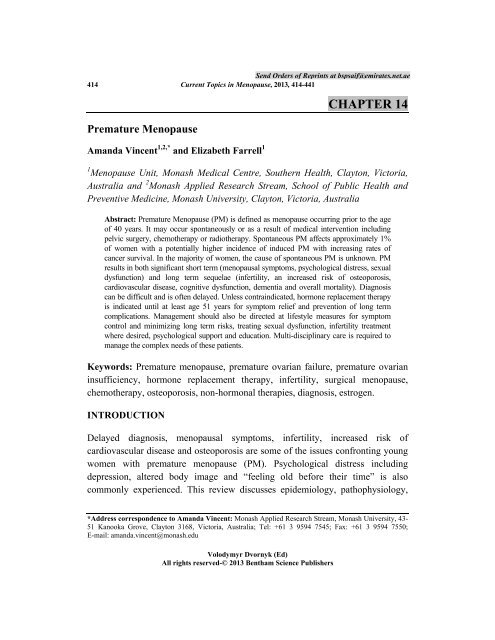Download - Bentham Science
Download - Bentham Science
Download - Bentham Science
You also want an ePaper? Increase the reach of your titles
YUMPU automatically turns print PDFs into web optimized ePapers that Google loves.
Send Orders of Reprints at bspsaif@emirates.net.ae<br />
414 Current Topics in Menopause, 2013, 414-441<br />
Premature Menopause<br />
Amanda Vincent 1,2,* and Elizabeth Farrell 1<br />
CHAPTER 14<br />
1 Menopause Unit, Monash Medical Centre, Southern Health, Clayton, Victoria,<br />
Australia and 2 Monash Applied Research Stream, School of Public Health and<br />
Preventive Medicine, Monash University, Clayton, Victoria, Australia<br />
Abstract: Premature Menopause (PM) is defined as menopause occurring prior to the age<br />
of 40 years. It may occur spontaneously or as a result of medical intervention including<br />
pelvic surgery, chemotherapy or radiotherapy. Spontaneous PM affects approximately 1%<br />
of women with a potentially higher incidence of induced PM with increasing rates of<br />
cancer survival. In the majority of women, the cause of spontaneous PM is unknown. PM<br />
results in both significant short term (menopausal symptoms, psychological distress, sexual<br />
dysfunction) and long term sequelae (infertility, an increased risk of osteoporosis,<br />
cardiovascular disease, cognitive dysfunction, dementia and overall mortality). Diagnosis<br />
can be difficult and is often delayed. Unless contraindicated, hormone replacement therapy<br />
is indicated until at least age 51 years for symptom relief and prevention of long term<br />
complications. Management should also be directed at lifestyle measures for symptom<br />
control and minimizing long term risks, treating sexual dysfunction, infertility treatment<br />
where desired, psychological support and education. Multi-disciplinary care is required to<br />
manage the complex needs of these patients.<br />
Keywords: Premature menopause, premature ovarian failure, premature ovarian<br />
insufficiency, hormone replacement therapy, infertility, surgical menopause,<br />
chemotherapy, osteoporosis, non-hormonal therapies, diagnosis, estrogen.<br />
INTRODUCTION<br />
Delayed diagnosis, menopausal symptoms, infertility, increased risk of<br />
cardiovascular disease and osteoporosis are some of the issues confronting young<br />
women with premature menopause (PM). Psychological distress including<br />
depression, altered body image and “feeling old before their time” is also<br />
commonly experienced. This review discusses epidemiology, pathophysiology,<br />
*Address correspondence to Amanda Vincent: Monash Applied Research Stream, Monash University, 43-<br />
51 Kanooka Grove, Clayton 3168, Victoria, Australia; Tel: +61 3 9594 7545; Fax: +61 3 9594 7550;<br />
E-mail: amanda.vincent@monash.edu<br />
Volodymyr Dvornyk (Ed)<br />
All rights reserved-© 2013 <strong>Bentham</strong> <strong>Science</strong> Publishers
















